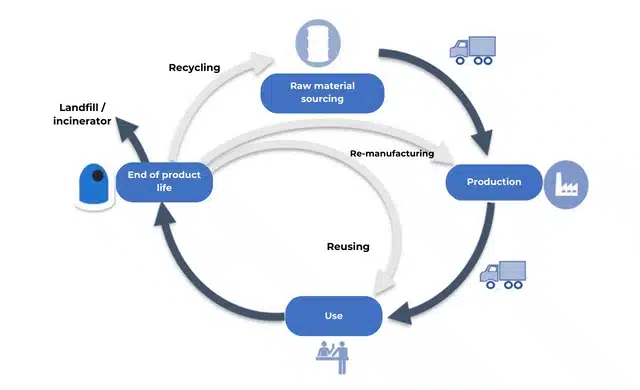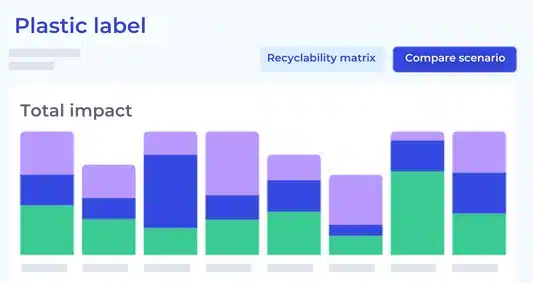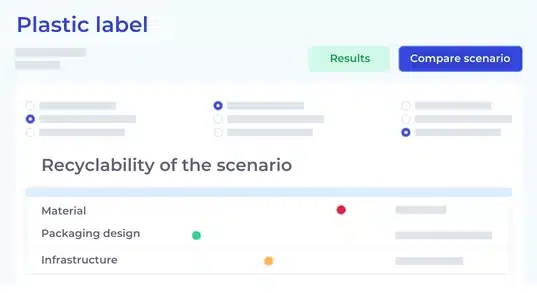
27 Feb Pack Impact: The new sustainability calculator
Index of contents:
In May of 2022, together with other companies that form part of the Packaging Cluster (Enplanter, Font Packaging, Glovo, NG Plastics and Virospack), Rieusset joined the Pack Impact project, which aims to:
- create a simplified online environmental quantification software based on Life Cycle Assessment (LCA), customized and adapted to the packaging value chain;
- obtain the carbon footprint of each of the company’s products, customized for each participating company;
- compare products with each other and with possible more eco-friendly alternatives.
In September 2023, the first demo of Pack Impact was delivered so that we could start entering data and testing. Since then, we at Rieusset have been testing our own products and analyzing results to find possible improvements.
Being part of this project is another example of our commitment to sustainability. We believe that once the test phase is over, this new tool will provide an added value that will differentiate us from other players in the market and other products, since with Pack Impact we will be able to find new and more sustainable alternatives for our clients and challenge ourselves to look for reduction and efficiency strategies that can mean a reduction in consumption and impact on our products.
In terms of environmental communication, it will be a before and after, since we will be able to quantitatively demonstrate all the changes we are making, how we are making them and what they imply.
In addition, legislation is increasingly aligned with sustainability and we must be prepared for all these changes that are sure to come. The tax on plastics has been the first, but more will come and this tool will be one of the keys to comply with the new regulations.
To better explain this new tool (still in the testing phase), we talked to one of our latest additions: Ángela Berbis Serrat, Sustainability Technician at Rieusset with a background in industrial design engineering, product development and sustainable design.
Life cycle analysis
Before getting into the subject, it is important to clarify what a life cycle analysis is, as this is what the Pack Impact tool is based on.
Life cycle analysis consists of analyzing a product from the origin of its materials until it reaches the end of its life (landfill), through production, distribution and use. It is a study that serves to:
- have a complete vision of the environmental aspects within the value chain;
- know where the most critical stages of a product’s life are;
- focus on them in search of solutions.
The life cycle analysis is based on ISO 14040 and the calculator uses this methodology to carry out the calculation and obtain results.
What is it for? To compare the environmental impact between different products and solutions, evaluating the most relevant environmental aspects, thus facilitating the most correct decision-making in terms of sustainability.
Life cycle inventory
The first step is to make an inventory of everything the life cycle asks of us:
- Materials: consumption of materials, their origin and transportation
- Manufacturing and assembly: consumption of energy, water and fuels
- Packaging grouping: consumption of packaging materials
- Palletizing: consumption of materials for palletizing
- Distribution: distances from point-of-sale and sales volume
- Use: number of uses (in our case this makes no sense since labels are not re-used)
- End of product life: waste management
All these calculations are made outside the tool and are then entered into Pack Impact, which works similarly to a form where data is entered in each field.
Impact categories
Once the data is entered, Pack Impact provides a table and a series of graphs with the results. The results imply the amount of impact generated by our products in each of the categories. These tables and graphs help us quantitatively identify the most critical stages of the value chain and focus on them.
In addition, Pack Impact offers the option to compare the results of different products. This impact comparison allows us to identify which products are more sustainable and why.
Life cycle analysis calculates the impact in different impact categories. An impact category is the set of possible effects on the environment as a result of human activities. The best known one is climate change, but there are many more. These are some of the different impact categories used by the calculator:
- Climate change: This refers to the increase in global temperature due to the combustion of fossil fuels and the release of greenhouse gases and CFCs. Some of its effects are the rise of sea water and extreme weather storms. This category is expressed in kg CO2 and is compatible for declaring the carbon footprint of products.
- Depletion of the ozone layer: This is the potential to destroy the ozone present in the upper layers of the atmosphere that acts as a barrier to the ultraviolet radiation our planet is exposed to. Its effect is basically UV radiation exposure, cataracts, skin cancer, etc.
- Acidification (or acid rain): This refers to the potential reduction of the pH of the environment. This means reduction of biodiversity, damage to terrestrial ecosystems, crops, ecosystems, aquaculture, impact on food production and corrosion of materials (stone, wood, etc.).
- Freshwater eutrophication: This expresses the excessive presence of critical elements in freshwater that cause changes in the species present and loss of biodiversity.
- Marine eutrophication: The same as freshwater eutrophication, but in sea water.
- Water use: Refers to the amount of water deprivation either by humans or by ecosystems.
- Depletion of abiotic resources: Refers to the depletion of mineral resources and metals. The main effects would be the destruction of habitats and ecosystems, disappearance of species, limitations on the development of products and services, and loss of opportunities for future generations.
- Human toxicity. Potential for harm to human health due to the use of many substances that can come into contact with people.
Recyclability matrix
Pack Impact, in addition to calculating the life cycle, offers an option to calculate the recyclability of a product.
The recyclability matrix qualitatively measures the recyclability of packaging according to material, package design and structure.
- Materials: types of materials and structures
- Designs: ease of separation and recovery of materials at the end of the packaging’s life.
- Infrastructure: the technical feasibility to recover materials and their subsequent valorization.
The result will be a table with the potential recyclability (low/medium/high) of the analyzed product for each of the blocks.
In the case of Rieusset, we are committed to recyclable materials or materials with recycled content, focusing lately on mono-materials to facilitate recycling. However, from now on you will no longer merely have our opinion, since we will give you the result of the calculator so that you can see for yourself.
If you want to make your products more sustainable, contact us and we will help you find the best solution to reduce your packaging’s impact on the environment.
| We Manufacture: | Meet Rieusset: |








